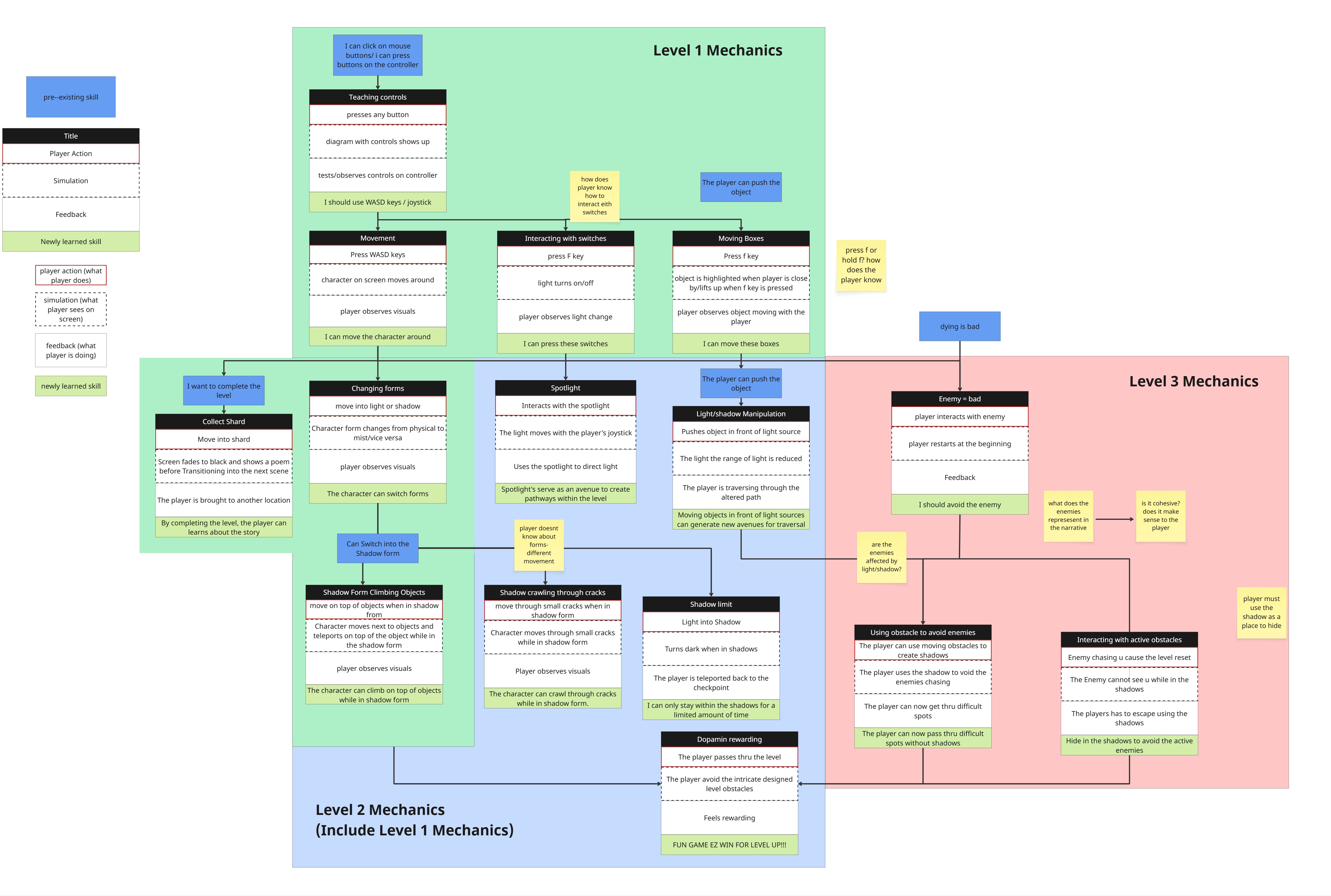Devlog #4: A Level Reborn
This week we circled back to the fundamentals. After digesting feedback from our previous builds, we went back to core design principles and did a deep dive into the building blocks of our mechanics. The result? A cleaner structure, a smarter level, and a better player experience.
Back to Basics: Skill Atoms Breakdown
The first thing our team focused on this week was creating a skill toms diagram to break down and define the core mechanics of our game. This exercise helped us reach a shared understanding of the game’s key systems and how they build on one another. With this structure in place, we were able to plan how levels should be designed to introduce mechanics in a clear, engaging, and intuitive progression for players.

A New Level One
Once we had a solid grasp of the mechanics and how they should be introduced, we began work on designing our first level. We split into two groups: one team of four focused on constructing Level 1, while the other team worked on designing puzzles that will appear in later levels.
Level 1 is divided into three puzzle sections, each designed to introduce the player to the game’s fundamental mechanics in a natural sequence.
Puzzle 1 – Light and Shadow Timing
The first puzzle teaches players about the core mechanic of switching between Nirvana (light form) and Dharma (shadow form). In this section, the player must carefully time their movement through a hallway where moving panels shift the lighting, creating alternating areas of light and shadow. Since players can't remain in shadow form for too long, this puzzle introduces the key tension and rhythm of managing both forms under time pressure.
Puzzle 2 – Switches and Environmental Interaction
The second puzzle introduces players to the concept of environmental manipulation by interacting with switches. Unlike the first puzzle, where lighting conditions were predetermined, this section gives players agency over their surroundings. One switch controls a sliding wall panel that alters the lighting in a specific part of the level, while another switch, placed in a shadowed area, raises a bridge to allow progression. Since switches can only be activated in Nirvana form and must be located in lit areas, this puzzle teaches players how to use one environmental element to enable interaction with another by changing which areas are lit and which are unlit. It emphasizes the idea that players can and must actively shape the world around them to move forward.
Puzzle 3 – Climbing and Moveable Blocks
The final puzzle of the level focuses on vertical traversal and environmental manipulation. In this section, the player gains new ways to both navigate and shape the environment. They are introduced to the climbing mechanic, which allows traversal of certain surfaces while in shadow form, adding a new dimension to movement tied to lighting conditions. This puzzle also introduces the ability to push and pull blocks, expanding the player’s toolkit for interacting with the world. Using UI text and visual outlines, we guide players in learning how to reposition blocks to create paths or cast shadows in strategic ways. This section reinforces the shadow traversal mechanic while encouraging more creative problem-solving through environmental interaction.
By the end of Level 1, players will have learned all the foundational mechanics: light-based form switching, interacting with switches to manipulate the environment, climbing in shadow form, and block manipulation. These core skills serve as the building blocks for more complex challenges in future levels.
User Experience Enhancements
For Level 1, we introduced several new UI features to improve the player experience. We added an object interaction UI that displays a key prompt when the player approaches an interactive object, such as “Press F to Raise Bridge” or “Hold F to Move Block.” This helps players understand what actions are possible in the moment. Highlighted outlines and subtle particle effects when the player is nearby also help to this effect, clearly indicating that it is interactable and distinct from static objects.
We also implemented a menu scene that allows the player to start the game, access a (currently incomplete) settings page, or quit. At the end of the level, we added a level complete screen that appears when the player reaches the memory shard. This screen displays a short poem, which advances the game’s narrative and will eventually serve as the transition into Level 2.
On the audio side, we implemented a range of sound effects to enhance immersion. These include sounds for walking, interacting with switches, moving blocks, and environmental changes like sliding walls or the bridge being raised. We also added a victory sound for completing the level, along with background music for the menu scene.
What’s Next
- Iterate on Level 1 based on playtesting
- Add controller support
- Commence creation of levels 2 and 3
- Animate the new Nirvana player model
- Refine block interaction feel and feedback
- Begin early lighting VFX and shader exploration for dynamic levels
Final Thoughts
This week wasn’t about adding more; it was about refining what matters. By grounding ourselves in core design principles and building a smarter first level, we’ve set the stage for everything that follows. Our foundations are much stronger now, and we’re ready to build upward.
Files
Get Truth and Shadows
Truth and Shadows
| Status | In development |
| Authors | iExploze, yilin sun, krishnacheemalapati, Barsamyan-D, ericz1368, JolineLa, David Lopez, R-Barnes |
| Genre | Puzzle |
| Languages | English |
More posts
- Devlog #5: Alpha build2 days ago
- Devlog #3: A Light in the Dark23 days ago
- Devlog #2: Light Refined, Shadows Reimagined30 days ago
- Devlog #1: Brainstorming & Demoing44 days ago
- Key Documents: Creative Brief, Team Charter, Game Design Document44 days ago
Leave a comment
Log in with itch.io to leave a comment.